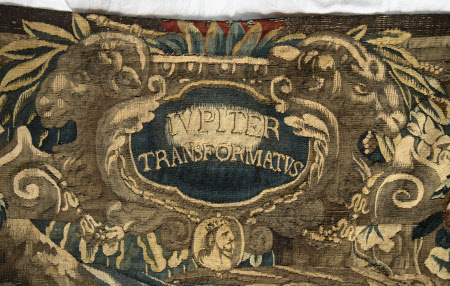Jupiter and Antiope
Flemish
Category
Tapestries
Date
circa 1660 - circa 1680
Materials
Tapestry, wool and silk, 5 warps per cm
Measurements
2.52 m (H); 4.54 m (W)
Place of origin
Belgium
Order this imageCollection
Speke Hall, Merseyside
NT 1197405.1
Summary
Tapestry, wool and silk, 5 warps per cm, Jupiter and Antiope, Flemish (possibly Brussels), c. 1660-1680. In the right foreground Antiope lies sleeping surrounded by attributes of the hunt – a horn, a bow and arrows, and dead game. A female companion lies behind her, also sleeping, and to their right is part of a stone fountain. To the left Jupiter, in the form of a Satyr, creeps towards Antiope on his hands and knees while his attribute of an eagle carrying a triple thunderbolt descends from the sky to draw aside a blue curtain sheltering the sleeping women. A young Cupid, holding a bow and naked save for a quiver of arrows slung across his shoulder, puts one finger to his lips as he watches the furtive Jupiter. To the left of the scene is a wooded landscape with two boy satyrs dancing and playing pipes and a distant view of a rocky valley beyond. The lateral borders are composed of figures of a man and a woman supporting columns with leaves twisting around them, and the top border is made up of garlands of fruit and flowers supported by ribbons and adorned with pairs of cherubs’ heads, a caduceus, and a central cartouche bearing the inscription: ‘IVPITER / TRANSFORMATVS’. There is no lower border.
Full description
Antiope appears in Greek mythology as a nymph or, in some sources, as the wife of the King of Thebes. Ovid's 'Metamorphoses' describes how Jupiter, in the form of a satyr, surprised her and ravished her, getting her pregnant with twins (Book 6). The two tapestries at Speke come from a series representing the various amorous conquests of Jupiter, under the collective title ‘Jupiter Transformatus’. Five panels from a different weaving of the series are in Schloss Bruchsal, Baden-Wurttemberg (Southern Germany), representing ‘Leda and the Swan’, ‘the Rape of Europa’, ‘Jupiter and Antiope’, ‘the Deception of Mnemosyne’, and a fragment of ‘Jupiter and Callisto’ (Weinheim 2002, cat. 3, pp. 47-52). Two further tapestries representing ‘Jupiter and Callisto’ and ‘The Rape of Ganymede’, probably from a third weaving of the set, were sold at Piasa, Paris, 23 November 2007, lot 251. Within the National Trust's collection there is one further tapestry from the series at Packwood House with the subject 'Leda and the Swan' (557842). The legend ‘IVPITER TRANSFORMATVS’ appears at the top of all these panels, except the Schloss Bruchsal ‘Jupiter and Callisto’ which has lost its borders. With the exception of the Rape of Ganymede, all of the episodes depicted in the 'Jupiter Transformatus' tapestries are mentioned in book VI of Ovid’s Metamorphoses, in the description of the tapestry woven by Arachne who challenged the goddess Minerva to a weaving competition. The story is one of divine vengeance: Arachne’s tapestry was deemed faultless, and so the proud Minerva punished her for her presumption by transforming her into a spider. Arachne’s choice of subject for her tapestry is evidence of her provocative challenge to the authority of the gods, as all the events she depicted involve the amorous gods deceiving mortals, often by transforming their outer appearance. The 'Jupiter Transformatus' series is a large-scale reconfiguration of the tapestry woven by Arachne, and a particularly fitting subject for tapestry. The borders on the Speke tapestries are similar to those on the Schloss Bruchsal, Piasa and Packwood examples. The man on the left represents Jupiter, holding his attribute of a three-pronged thunderbolt and with an eagle above his head, and on the right is Diana with her bow and arrows. The caduceus which appears in the top and bottom borders is the attribute of Mercury, Jupiter’s son, who assisted him in his seduction of Europa, and the cherubs’ heads and pairs of turtle doves are symbols of love and thus appropriate to the general theme of the set. The origin of the tapestry series cannot be pinpointed exactly. The Schloss Bruchsal set is catalogued as either Antwerp or Bruges, but the series may in fact have been woven in Brussels. Similar borders appear on a set of ‘Hunts’ by the Brussels weavers Everaert Leyniers (1597-1680) and Henrich I Reydams (c.1600-1699) and dated c.1645-1650, in the Musées royaux d’Art et d’Histoire, Brussels (Bauer 1977, pp. 85-97). The 'Jupiter Transformatus' tapestries are mentioned in a 1917 inventory of Speke, when they were stored in an oak chest in St Raymond's Bedroom, with a note that they were 'formerly on wall in Corridor'. In the 1964 inventory they appear hanging in the Blue Bedroom. (Helen Wyld, 2012)
Provenance
Miss Adeleide Watt (1857-1921); Trustees of the late Miss Adeleide Watt, 1921-1942; National Trust from 1943
Credit line
Speke Hall, the Adeleide Watt Collection (The National Trust)
Marks and inscriptions
Cartouche on upper border : IVPITER / TRANSFORMATVS
Makers and roles
Flemish, workshop Brussels , workshop
References
Bauer, 1977: Rotraud Bauer, ‘Tapisseries bruxelloises du siècle de Rubens’, exh. cat. Musées royaux d’art et d’Histoire, Brussels 1977 Weinheim, 2002: Tapisserien Wandteppiche aus den staatlichen Schlössern Baden-Württembergs, Schätze aus unseren Schlössern Eine Reihe der Staatlichen Schlösser und Gärten, Baden-Württemberg, vol. 6, Weinheim 2002 Pauline Junquera de Vega & Carmen Díaz Gallegos, Catálogo de Tápices del Patrimonio Nacional, Volumen II: Siglo XVII, Madrid 1986




